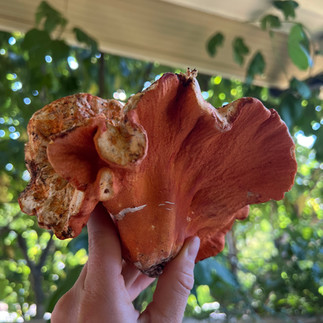Lobster Mushroom Bisque: Recipe and Tips on Mushroom Cleaning
- Abigail Schmitt
- Jul 25, 2024
- 5 min read
A recipe for one of my favorite foraged mushrooms, this Lobster Mushroom Bisque is foolproof and ideal for those more imperfect mushrooms.

Mushroom Cleaning: Here are my best tips on choosing which mushrooms to cook up, and how to clean foraged mushrooms, and best tools to use:
Clean in the field: Brush or scrape the dirt off of your mushrooms right away: this will help out in the kitchen in many ways. Lobster mushrooms and Boletes specifically grow in the dirt, and are fairly moist, so by the time you get to your kitchen, the mushrooms will have dried out on the surface. Dirt is easier to remove when it isn’t too dry.
For dirt, pine needles, bark, etc., a vegetable brush (soft and hard bristles) and a paring knife are the best options! I have an Opinel knife I bring with me everywhere, as well as a mini knife on a keychain I bring with me when I go trail running. I love this multitool from Opinel which has a brush and curved blade perfect for cleaning right in the field.
For bugs: Identify which parts of the mushroom have bugs, and cut them off in the field. It is best to keep them whole, but if you’re not sure if it’s worth it to bring it home (heavy porcinis especially) cut it in half to check. Unblemished mushrooms will be free of lines, and have no worms. Slugs also love to eat mushrooms, but often will not destroy the whole thing - you can find morels or chanterelles that have been chomped on which are perfectly edible. If it does have bugs: cut each into slices and soak in water with a dash of vinegar and salt for about 5-10 minutes. 1 ts salt to 1 litre of water, and 1 tbs of vinegar. Pull the mushrooms out with your hands to drip into a colander (bugs will mostly sink, mushrooms will float) Dry out on a rack or in a dehydrator. The vinegar helps to sterilize the mushroom and the salt will help the mushroom retain its water.
As always, make sure you properly identify your mushrooms or have an expert do so before cooking and consuming. Make sure you thoroughly cook your mushrooms before eating them, and if you’re trying a new edible mushroom, maybe just try a little bit to see how your stomach takes it. Everyone has different sensitivity levels! Lastly, make sure that they are properly cooked and seasoned! On that note…
I am hosting an outdoor mushroom cooking class this fall in Bellingham! I have two dates and locations available. Using foraged and store-bought mushrooms, I will be hosting a cooking demo and then we will get hands on with cleaning, preparing and cooking mushrooms to best bring out the flavor and texture of different types of mushrooms. Cooking techniques we will cover will include open fire cooking + grilling, sautéing and methods for preservation. You will leave with a handful of recipes and a full stomach! Surprise mycologist expert from the NorthWest Mushroom Association will walk with us through foraging basics, edible mushroom identification, where to find edibles in the PNW.
INGREDIENTS |
|---|
3 lbs lobster mushrooms, cleaned & thinly sliced |
6 tbs butter |
2 tbs olive oil |
4 large shallots, finely chopped |
2 carrots, finely chopped |
2 ribs celery, finely chopped |
2 clove garlic, finely chopped |
1 large yellow onion, finely chopped |
2 tbs tomato paste |
Kosher salt & pepper, to taste |
12 sprigs parsley |
6 sprigs thyme |
2 large bay leaves |
2 cups white wine |
6 cups vegetable stock |
1 tsp tabasco sauce |
1 cup heavy cream or 1 c cashews, soaked |
1 tbs chopped parsley |
Instructions:
|
Substitutions:
Lobster mushrooms: chicken of the woods or cremini can be used if you have found a small amount of lobster mushroom, but not enough for this recipe. Other favorite recipes for lobster mushrooms include lobster mushroom roll, and "seafood" pasta with sautéed lobster mushrooms.








